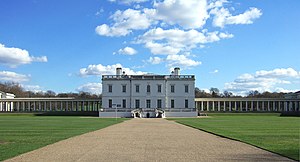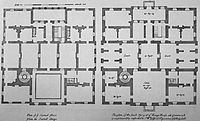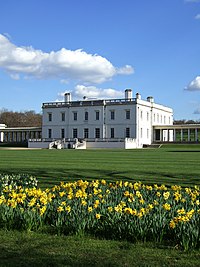User talk:Russ McGinn/Queen's House, Greenwich: Difference between revisions
imported>Russ McGinn (copy of wikipedia article for rewriting) |
John Leach (talk | contribs) m (Text replacement - "World Heritage Site" to "World Heritage site") |
||
| (One intermediate revision by one other user not shown) | |||
| Line 1: | Line 1: | ||
[[Image:Queens House.jpg|300px|thumb|right|The Queen's House, viewed from the main gate]] | [[Image:Queens House.jpg|300px|thumb|right|The Queen's House, viewed from the main gate]] | ||
The '''Queen's House, Greenwich''', was designed and begun in [[1614]]-[[1617]] by [[architect]] [[Inigo Jones]], early in his architectural career, for [[Anne of Denmark]], the queen of King [[James I of England]]. It was altered and completed by Jones, in a second campaign about 1635 for [[Henrietta Maria of France|Henrietta Maria]], queen of King [[Charles I of England|Charles I]].<ref>The detailed accounting of the building project is laid out in London County Council, ''Survey of London'', Howard Colvin, ed. ''The History of The King's Works'', Volume IV, 1485-1660, Part II 9) and in John Bold, ''Greenwich: An Architectural History of the Royal Hospital for Seamen and the Queen's House'' (Yales University Press) 2000.</ref> The Queen's House is one of the most important buildings in [[Architecture of the United Kingdom|British architectural]] history, being the first consciously [[Classical architecture|classical]] building to have been | The '''Queen's House, Greenwich''', was designed and begun in [[1614]]-[[1617]] by [[architect]] [[Inigo Jones]], early in his architectural career, for [[Anne of Denmark]], the queen of King [[James I of England]]. It was altered and completed by Jones, in a second campaign about 1635 for [[Henrietta Maria of France|Henrietta Maria]], queen of King [[Charles I of England|Charles I]].<ref>The detailed accounting of the building project is laid out in London County Council, ''Survey of London'', Howard Colvin, ed. ''The History of The King's Works'', Volume IV, 1485-1660, Part II 9) and in John Bold, ''Greenwich: An Architectural History of the Royal Hospital for Seamen and the Queen's House'' (Yales University Press) 2000.</ref> The Queen's House is one of the most important buildings in [[Architecture of the United Kingdom|British architectural]] history, being the first consciously [[Classical architecture|classical]] building to have been constructed in Britain. It was Jones's first major commission after returning from his 1613-1615 [[grand tour]]<ref>The phrase 'Grand Tour' was unknown until approximately 1670, but in essence, Jones's tour of Germany, Italy and France, incorporated many of the elements of the later tour.</ref> of [[Roman architecture|Roman]], [[Renaissance architecture|Renaissance]] and [[Palladian architecture]] in Italy. Some earlier English buildings, such as [[Longleat]], had made borrowings from the classical style; but these were restricted to small details and were not applied in a systematic way. Nor was the form of these buildings informed by an understanding of classical precedents. The Queen's House would have appeared revolutionary to English eyes in its day. Jones is credited with the introduction of [[Palladianism]] with the construction of the Queen's House. Although it diverges from the mathematical constraints of Palladio and it is likely that the immediate precedent for the H shaped plan, straddling a road is the [[Villa Medici at Poggio a Caiano]] by Giuliano da Sangallo. <!--add sentence regarding the requirement to maintain views of the river after demoltion of the palace of placentia-->Today it is both a [[grade I listed building]] and a [[Scheduled ancient monument]] a status which includes the 115 foot wide, axial vista to the River Thames. | ||
==Early history== | ==Early history== | ||
[[Image:Queen's House plan.jpg|thumb|200px|Plans of the Queen's House. The salon is a 40-foot (12.2 metre) cube.]] | [[Image:Queen's House plan.jpg|thumb|200px|Plans of the Queen's House. The salon is a 40-foot (12.2 metre) cube.]] | ||
The Queen's House is located in [[Greenwich, London]], [[England]]. It was built as an adjunct to the [[Palace of Placentia|Palace of Greenwich]], previously known | The Queen's House is located in [[Greenwich, London]], [[England]]. It was built as an adjunct to the Tudor [[Palace of Placentia|Palace of Greenwich]], previously known, before its redevelopment by [[Henry VII]]<ref>The Palace of Placentia was redeveloped circa 1500</ref>as the Palace of Placentia, which was a rambling, mainly red-brick building in a more vernacular style. This would have presented a dramatic contrast of appearance to the newer, white-painted House, although the latter was much smaller and really a modern version of an older tradition of private 'garden houses', not a public building, and one used only by the queen's privileged inner circle. However, the House's original use was short - no more than seven years - before the [[English Civil War]] began in [[1642]] and swept away the court culture from which it sprang. Of its interiors, three ceilings<ref>A further ceiling ''Allegory of Peace and the Arts'', by [[Orazio Gentileschi]], is installed at [[Marlborough House]], London (R.W. Bissell, ''Orazio Gentileschi and the Poetic Tradition in Caravaggiesque Painting''[1981], cat. no. 70, pp 195-98).</ref> and some wall decorations survive in part, but no interior remains in its original state. This process began as early as 1662, when masons removed a niche and term figures and a chimneypiece.<ref>John Newman, noting this, identified a chimneypiece likely to have come from the Queen's House, at [[Charlton House]], barely three miles away; for its design it drew upon an engraving in [[Jean Barbet]]'s ''Livre d'architecture'' (1633); Newman, "Strayed from the Queen's House?" ''Architectural History'' '''27''', Design and Practice in British Architecture: Studies in Architectural History Presented to Howard Colvin (1984:33-35). </ref> | ||
[[Image:Queens House 2006.jpg|thumb|200px|left|The Queen's House, Greenwich]] | [[Image:Queens House 2006.jpg|thumb|200px|left|The Queen's House, Greenwich]] | ||
the Queen's House, though it was scarcely being used, provided the distant focal center for Sir [[Christopher Wren]]'s [[Greenwich Hospital]], with a logic and grandeur that has seemed inevitable to architectural historians but were motivated by [[Mary II of England|Mary II]]'s insistence that the vista to the water from the Queen's House not be impaired.<ref>Bold 2000.</ref> | the Queen's House, though it was scarcely being used, provided the distant focal center for Sir [[Christopher Wren]]'s [[Greenwich Hospital]], with a logic and grandeur that has seemed inevitable to architectural historians but were motivated by [[Mary II of England|Mary II]]'s insistence that the vista to the water from the Queen's House not be impaired.<ref>Bold 2000.</ref> | ||
==Construction of the Greenwich Hospital== | ==Construction of the Greenwich Hospital== | ||
Although the House survived as an official building—being used for the lying-in-state of | Although the House survived as an official building—being used for the lying-in-state of Commonwealth Generals-at-Sea Richard Dean (1653) and [[Robert Blake (admiral)|Robert Blake]] ([[1657]])—the main palace was progressively demolished from the [[1660s]] to [[1690s]] and replaced by the the [[Greenwich Hospital (London)|Royal Hospital for Seamen]]<ref>The Royal Hospital for Seamen is usually known as Greenwich Hospital.</ref>, built [[1696]]-[[1751]] to the master-plan of Sir [[Christopher Wren]]. This is now called the Old Royal Naval College, after its later use from [[1873]] to [[1998]]. The position of the House, and Queen [[Mary II of England|Mary II]]'s order that it retain its view to the river (only gained on demolition of the older Palace), dictated Wren's Hospital design of two matching pairs of 'courts' separated by a grand 'visto' exactly the width of the House (115 feet). The whole forms an impressive architectural ensemble that stretches from the [[Thames]] to [[Greenwich Park]] and is one of the principal features that in 1997 led [[UNESCO]] to inscribe 'Maritime Greenwich' as a [[World Heritage site]]. | ||
[[Image:Queen's house from the South.jpg|thumb|200px|right|The Queen's House viewed from the foot of Observatory Hill, showing the original house (1635) and the additional wings linked by colonades (1807)]] | [[Image:Queen's house from the South.jpg|thumb|200px|right|The Queen's House viewed from the foot of Observatory Hill, showing the original house (1635) and the additional wings linked by colonades (1807)]] | ||
==19th Century additions== | ==19th Century additions== | ||
From [[1806]] the House itself was the centre of what, from [[1892]], became the [[Royal Hospital School]] for the sons of seamen. This necessitated new accommodation wings, and a flanking pair to east and west were added and connected to the House by [[colonnade]]s from [[1807]] (designed by [[London Docks]] architect [[Daniel Asher Alexander]]), with further surviving extensions up to [[1876]]. In [[1933]] the school moved to [[Holbrook, Suffolk]]. Its Greenwich buildings, including the House, were converted and restored to become the new [[National Maritime Museum]] (NMM), created by [[Act of Parliament]] in [[1934]] and opened in [[1937]]. | From [[1806]] the House itself was the centre of what, from [[1892]], became the [[Royal Hospital School]] for the sons of seamen. This necessitated new accommodation wings, and a flanking pair to east and west were added and connected to the House by [[colonnade]]s from [[1807]] (designed by [[London Docks]] architect [[Daniel Asher Alexander]]), with further surviving extensions up to [[1876]]. In [[1933]] the school moved to [[Holbrook, Suffolk]]. Its Greenwich buildings, including the House, were converted and restored to become the new [[National Maritime Museum]] (NMM), created by [[Act of Parliament]] in [[1934]] and opened in [[1937]]. | ||
The | The grounds immediately to the north of the House were reinstated in the late 1870s following construction of the [[Cut-and-cover#construction|cut-and-cover]] [[tunnel]] between [[Greenwich station|Greenwich]] and [[Maze Hill railway station|Maze Hill]] stations. The tunnel comprised the continuation of the [[London and Greenwich Railway]] and opened in 1878. | ||
[[Image:TulipStair QueensHouse Greenwich.jpg|thumb|left|200px|The Tulip Stairs and lantern from below; the first centrally unsupported spiral stairs constructed in England. The stairs are supported by a combination of support by [[cantilever]] from the walls and each tread resting on the one below.]] | [[Image:TulipStair QueensHouse Greenwich.jpg|thumb|left|200px|The Tulip Stairs and lantern from below; the first centrally unsupported spiral stairs constructed in England. The stairs are supported by a combination of support by [[cantilever]] from the walls and each tread resting on the one below.]] | ||
==Recent years== | ==Recent years== | ||
The House was further restored between 1986 and 1999, and it is now largely used to display the Museum's substantial collection of marine paintings and portraits (mainly of the [[17th century|17th]] to [[20th century|20th centuries]], | The House was further restored between 1986 and 1999, and it is now largely used to display the Museum's substantial collection of marine paintings and portraits (mainly of the [[17th century|17th]] to [[20th century|20th centuries]], and for other public and private events. It is normally open to the public daily, free of charge, along with the other museum galleries and the 17th-century [[Royal Greenwich Observatory|Royal Observatory, Greenwich]], which is also part of the National Maritime Museum. | ||
The '''"Queen's House"''' was also the name used for Buckingham House, later to be rebuilt as [[Buckingham Palace]], when it was [[Charlotte of Mecklenburg-Strelitz|Queen Charlotte]]'s residence during the reign of [[George III of the United Kingdom|George III]]. | The '''"Queen's House"''' was also the name used for Buckingham House, later to be rebuilt as [[Buckingham Palace]], when it was [[Charlotte of Mecklenburg-Strelitz|Queen Charlotte]]'s residence during the reign of [[George III of the United Kingdom|George III]]. | ||
Latest revision as of 10:34, 7 March 2024
The Queen's House, Greenwich, was designed and begun in 1614-1617 by architect Inigo Jones, early in his architectural career, for Anne of Denmark, the queen of King James I of England. It was altered and completed by Jones, in a second campaign about 1635 for Henrietta Maria, queen of King Charles I.[1] The Queen's House is one of the most important buildings in British architectural history, being the first consciously classical building to have been constructed in Britain. It was Jones's first major commission after returning from his 1613-1615 grand tour[2] of Roman, Renaissance and Palladian architecture in Italy. Some earlier English buildings, such as Longleat, had made borrowings from the classical style; but these were restricted to small details and were not applied in a systematic way. Nor was the form of these buildings informed by an understanding of classical precedents. The Queen's House would have appeared revolutionary to English eyes in its day. Jones is credited with the introduction of Palladianism with the construction of the Queen's House. Although it diverges from the mathematical constraints of Palladio and it is likely that the immediate precedent for the H shaped plan, straddling a road is the Villa Medici at Poggio a Caiano by Giuliano da Sangallo. Today it is both a grade I listed building and a Scheduled ancient monument a status which includes the 115 foot wide, axial vista to the River Thames.
Early history
The Queen's House is located in Greenwich, London, England. It was built as an adjunct to the Tudor Palace of Greenwich, previously known, before its redevelopment by Henry VII[3]as the Palace of Placentia, which was a rambling, mainly red-brick building in a more vernacular style. This would have presented a dramatic contrast of appearance to the newer, white-painted House, although the latter was much smaller and really a modern version of an older tradition of private 'garden houses', not a public building, and one used only by the queen's privileged inner circle. However, the House's original use was short - no more than seven years - before the English Civil War began in 1642 and swept away the court culture from which it sprang. Of its interiors, three ceilings[4] and some wall decorations survive in part, but no interior remains in its original state. This process began as early as 1662, when masons removed a niche and term figures and a chimneypiece.[5]
the Queen's House, though it was scarcely being used, provided the distant focal center for Sir Christopher Wren's Greenwich Hospital, with a logic and grandeur that has seemed inevitable to architectural historians but were motivated by Mary II's insistence that the vista to the water from the Queen's House not be impaired.[6]
Construction of the Greenwich Hospital
Although the House survived as an official building—being used for the lying-in-state of Commonwealth Generals-at-Sea Richard Dean (1653) and Robert Blake (1657)—the main palace was progressively demolished from the 1660s to 1690s and replaced by the the Royal Hospital for Seamen[7], built 1696-1751 to the master-plan of Sir Christopher Wren. This is now called the Old Royal Naval College, after its later use from 1873 to 1998. The position of the House, and Queen Mary II's order that it retain its view to the river (only gained on demolition of the older Palace), dictated Wren's Hospital design of two matching pairs of 'courts' separated by a grand 'visto' exactly the width of the House (115 feet). The whole forms an impressive architectural ensemble that stretches from the Thames to Greenwich Park and is one of the principal features that in 1997 led UNESCO to inscribe 'Maritime Greenwich' as a World Heritage site.
19th Century additions
From 1806 the House itself was the centre of what, from 1892, became the Royal Hospital School for the sons of seamen. This necessitated new accommodation wings, and a flanking pair to east and west were added and connected to the House by colonnades from 1807 (designed by London Docks architect Daniel Asher Alexander), with further surviving extensions up to 1876. In 1933 the school moved to Holbrook, Suffolk. Its Greenwich buildings, including the House, were converted and restored to become the new National Maritime Museum (NMM), created by Act of Parliament in 1934 and opened in 1937.
The grounds immediately to the north of the House were reinstated in the late 1870s following construction of the cut-and-cover tunnel between Greenwich and Maze Hill stations. The tunnel comprised the continuation of the London and Greenwich Railway and opened in 1878.

Recent years
The House was further restored between 1986 and 1999, and it is now largely used to display the Museum's substantial collection of marine paintings and portraits (mainly of the 17th to 20th centuries, and for other public and private events. It is normally open to the public daily, free of charge, along with the other museum galleries and the 17th-century Royal Observatory, Greenwich, which is also part of the National Maritime Museum.
The "Queen's House" was also the name used for Buckingham House, later to be rebuilt as Buckingham Palace, when it was Queen Charlotte's residence during the reign of George III.
Notes
- ↑ The detailed accounting of the building project is laid out in London County Council, Survey of London, Howard Colvin, ed. The History of The King's Works, Volume IV, 1485-1660, Part II 9) and in John Bold, Greenwich: An Architectural History of the Royal Hospital for Seamen and the Queen's House (Yales University Press) 2000.
- ↑ The phrase 'Grand Tour' was unknown until approximately 1670, but in essence, Jones's tour of Germany, Italy and France, incorporated many of the elements of the later tour.
- ↑ The Palace of Placentia was redeveloped circa 1500
- ↑ A further ceiling Allegory of Peace and the Arts, by Orazio Gentileschi, is installed at Marlborough House, London (R.W. Bissell, Orazio Gentileschi and the Poetic Tradition in Caravaggiesque Painting[1981], cat. no. 70, pp 195-98).
- ↑ John Newman, noting this, identified a chimneypiece likely to have come from the Queen's House, at Charlton House, barely three miles away; for its design it drew upon an engraving in Jean Barbet's Livre d'architecture (1633); Newman, "Strayed from the Queen's House?" Architectural History 27, Design and Practice in British Architecture: Studies in Architectural History Presented to Howard Colvin (1984:33-35).
- ↑ Bold 2000.
- ↑ The Royal Hospital for Seamen is usually known as Greenwich Hospital.



